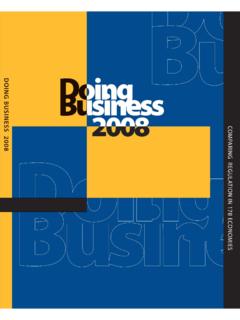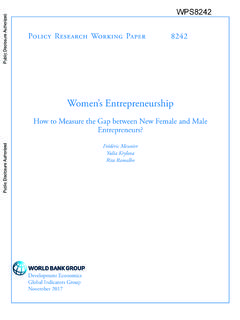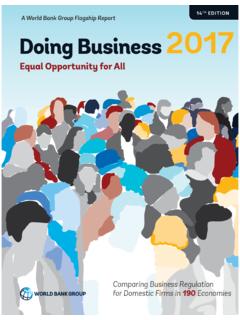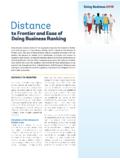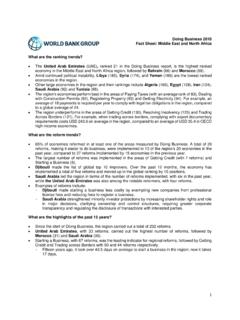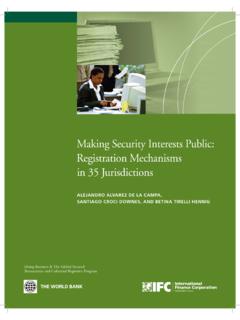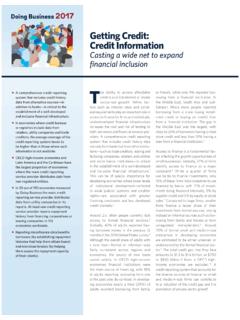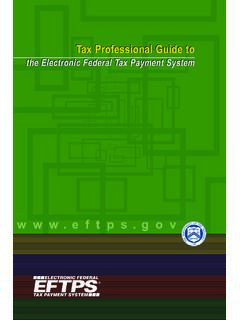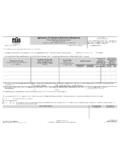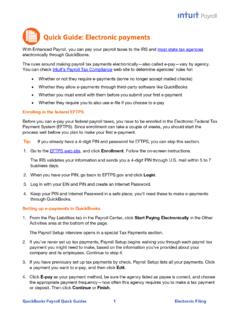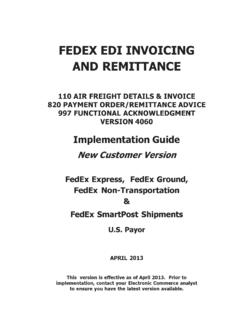Transcription of Implementing electronic tax filing and payments in …
1 Taxation is essential for sustainable eco-nomic development, and tax administra-tion is a basic function of a successful state. Taxation also helps make a govern-ment accountable to its citizens. When governments spend taxpayers money, they are more accountable to make bud-get decisions transparent and accessible. By 2012, 76 of the economies measured by Doing Business had implemented elec-tronic tax filing and payment systems. This case study examines Malaysia s ex-perience with modernizing manual tax fil-ing and payment and moving to a paper-less online system.
2 Malaysia shows the opportunities that technology can pro-vide to taxpayers and governments as well as the challenges that may emerge during the transition. In 2004 Malaysia s Inland Revenue Board (IRB) spearheaded an initiative to imple-ment a system for filing and paying taxes that would promote electronic , paperless transactions. IRB s goal was to become a global leader in tax administration. It sought to shift from the conventional way of submitting paper forms to earn the public s trust and confidence. Tax systems in developing economies, like those in more developed ones, face both new challenges and new possibilities as a result of technological change.
3 Malaysia s ongoing reform of its electronic tax filing and payment system shows how and un-der what conditions technology can ben-efit both tax authorities and OF electronic TAX FILING AND PAYMENTThe goal of any tax authority is to estab-lish a system of tax administration that allows for the collection of required taxes at minimum cost. A tax authority engag-es in many activities, such as processing returns and related information from tax-payers, entering tax return data into a da-tabase, matching returns against filing re-quirements, processing tax payments and matching them against assessments, and issuing assessments and refunds.
4 One way to boost a tax authority s efficiency is by expanding its use of information and communication technology. Such technology can facilitate a broad range of services, including registering taxpayers, filing returns, processing payments , is-suing assessments and checking against third-party information. E-filing systems increase the quality and quantity of information available to tax officers, enabling them to complete trans-actions faster and more accurately. Re-turns filed electronically have much lower error rates than paper returns and sub-stantially cut the need to impose penal-ties and other punitive measures to foster compliance.
5 The more efficient handling provided by electronic returns allows tax officers to issue assessments and refunds more quickly, and taxpayers know right away if their returns have been accepted by the tax E-filing lowers the cost of handling returns allowing ad-ministrative resources to be reallocated to other tasks such as auditing, customer services and tracking benefits of e-filing and e-payment systems extend to other electronic pro-cesses in the tax authority. E-filing and e-payment allow for better, safer data storage that can be used to implement a risk management system for auditing and enforcement.
6 Automation helps estab-lish a good system for tracking case files, which is essential for effective auditing Implementing electronic tax filing and payments in Malaysia By 2012, 76 of the economies measured by Doing Business had implemented electronic tax filing (e-filing) and electronic payment (e-payment) systems. In 2004 Malaysia s Inland Revenue Board (IRB) launched e-filing and e-payment for income taxes. IRB encountered several implementation challenges, key among them the public s initial reluctance to use the new system. So IRB increased its promotion efforts, upgraded the system and hired staff to show taxpayers how to use it.
7 The number of individuals and companies using e-filing jumped from 5% of active taxpayers in 2006 to 37% in 2012. The time that businesses need to comply with Malaysia s tax regulations fell from 190 hours in 2004 to 133 in 2012 as measured by Doing increases the speed and quality of data provided to In addition, e-filing systems are usually complement-ed by software that standardizes and fa-cilitates processes for taxpayers, making compliance easier. Finally, well-designed electronic systems can lower corruption by reducing face-to-face interactions.
8 To ensure that taxes are collected efficiently and reduce opportu-nities for corruption, a generally accepted principle is that tax authorities should not handle money directly. Ideally, tax offi-cials should have little direct contact with taxpayers and so less discretion in decid-ing how to treat them. E-filing is also easy, flexible and con-venient for taxpayers. E-filing makes it possible to file returns from a taxpayer s home, library, financial institution, work-place, tax professional s business or even stores and shopping malls. With an in-tegrated e-filing and e-payment system, taxes can be filed and paid online from any GLOBAL EXPERIENCES WITH AND LESSONS FROM electronic FILING Singapore was one of the first economies to adopt electronic systems in its public administration.
9 In 1992 the Inland Rev-enue Department was replaced by the Inland Revenue Authority of Singapore, which developed an integrated, comput-erized tax administration authority s first step was shifting from a hard-copy filing system to pa-perless imaging. Going electronic made administrative processes more efficient by freeing staff from unproductive pa-per shuffling, enabling better taxpayer service. The time needed to issue as-sessments dropped from 12 18 months to 3 5 between 1992 and This change allowed staff to work more on auditing and investigation.
10 Automated standard taxation procedures also made the system less dependent on the sub-jective expertise of individual tax officers, reducing the potential for corruption. Re-turn processing, auditing and payment functions were separated, and officials attitudes toward taxpayers improved. Chile s Internal Revenue Service was the country s first public agency to adopt on-line technology well before most other public services. electronic methods were intended to facilitate tax compliance and decrease direct interaction with taxpay-ers. Chile is one of the few economies that have managed to approach nearly 100% use of electronic systems.


